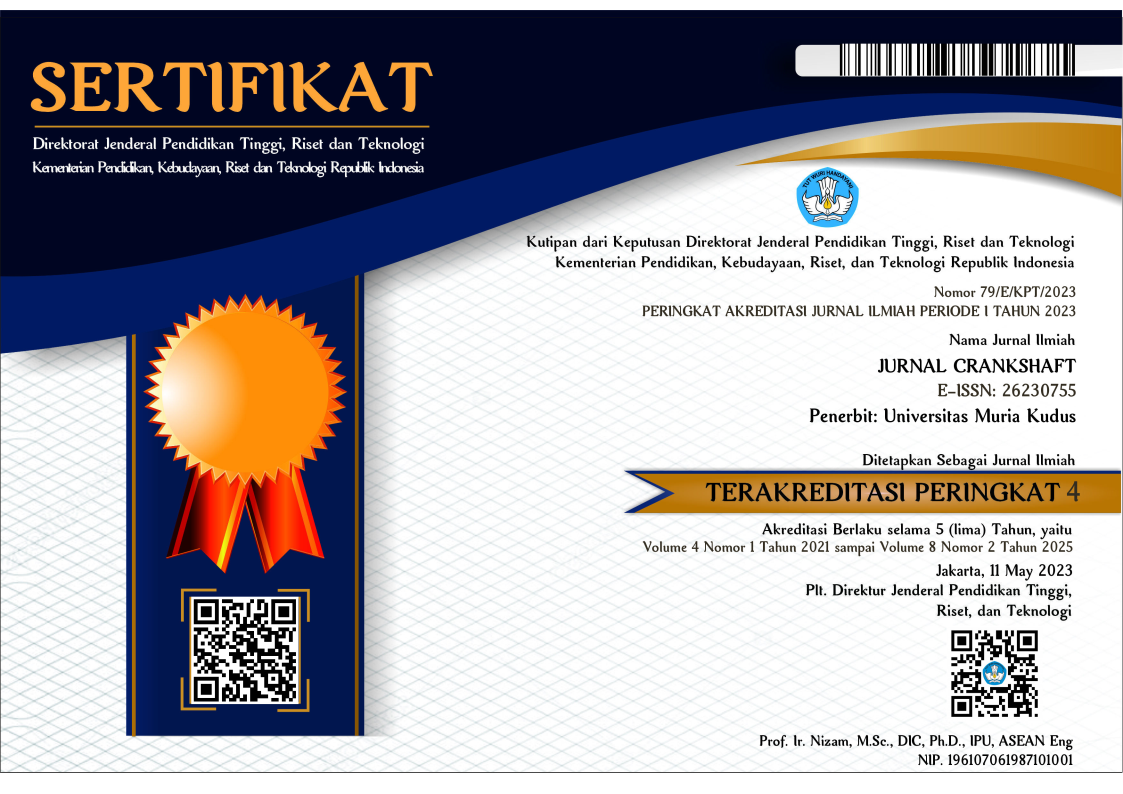Studi pengaruh debit dan jumlah tingkat runner terhadap efisiensi turbin vorteks PLTPH
Sari
Kata Kunci
Teks Lengkap:
PDFReferensi
B. P. J. Barat, “Provinsi Jawa Barat Dalam Angka 2023,” Bandung, 2023. [Online]. Available: https://jabar.bps.go.id/publication/2023/02/28/57231a828abbfdd50a21fe31/provinsi-jawa-barat-dalam-angka-2023.html [2] E. D. Darmawan, “4.000 Rumah di Majalengka Belum Teraliri Listrik Mandiri,” detikJabar, 2023. https://www.detik.com/jabar/berita/d-6733747/4000-rumah-di-majalengka-belum-teraliri-listrik-mandiri (accessed Aug. 01, 2023). [3] Badan Standardisasi Nasional, Klasifikasi Pembangkit Listrik Tenaga Air. Indonesia, 2019, p. 11. [Online]. Available: http://sispk.bsn.go.id/SNI/DetailSNI/12551 [4] IESR, “Indonesia Energy Transition Outlook 2023: Tracking Progress of Energy Transition in Indonesia: Pursuing Energy Security in the Time of Transition,” p. Please cite this report as: IESR (2022). Indonesia, 2023, [Online]. Available: www.irena.org [5] B. H. B. R. Nasional, “PLT Piko Hidro Tingkatkan Ketersediaan Energi Listrik untuk Daerah Tertinggal,” Bandung-Humas Badan Riset Nasional, 2023. https://www.brin.go.id/news/111325/plt-piko-hidro-tingkatkan-ketersediaan-energi-listrik-untuk-daerah-tertinggal [6] B. S. N. Indonesia, Spesifikasi teknis pembangkit listrik tenaga pikohidro, vol. 1, no. November. Indonesia: Badan Standardisasi Nasional, 2018, p. 15. [Online]. Available: https://drive.esdm.go.id/wl/?id=rdJ65Pu3Tl1p3e4B0sJJPrImMwcYp2P5 [7] Politeknik Negeri Bandung, Rencana Induk Penelitian Politeknik Negeri Bandung 2021-2025. Indonesia, 2021, p. 63. [Online]. Available: https://sippm.polban.ac.id/file_downloads/Rencana_Induk_Penelitian_(RIP)_Polban_Tahun_2021_-_2025_29c33305-5944-4829-b5a8-20b7ccd3520c.pdf [8] Haryadi, A. M. Subarjah, and Sugianto, “Experimental study on 3D vortex gravitational turbine runner,” AIP Conf. Proc., vol. 2296, no. January 2021, 2020, doi: 10.1063/5.0030545. [9] S. Dhakal et al., “Comparison of cylindrical and conical basins with optimum position of runner: Gravitational water vortex power plant,” Renew. Sustain. Energy Rev., vol. 48, pp. 662–669, 2015, doi: 10.1016/j.rser.2015.04.030. [10] T. R. Bajracharya et al., “Effects of Geometrical Parameters in Gravitational Water Vortex Turbines with Conical Basin,” J. Renew. Energy, vol. 2020, no. Figure 1, pp. 1–16, 2020, doi: 10.1155/2020/5373784. [11] N. Maika, W. Lin, and M. Khatamifar, “A Review of Gravitational Water Vortex Hydro Turbine Systems for Hydropower Generation,” Energies, vol. 16, no. 14, 2023, doi: 10.3390/en16145394. [12] M.-S. Kim, D. S. Edirisinghe, H.-S. Yang, S. D. G. S. P. Gunawardane, and Y.-H. Lee, “Effects of blade number and draft tube in gravitational water vortex power plant determined using computational fluid dynamics simulations,” J. Adv. Mar. Eng. Technol., vol. 45, no. 5, pp. 252–262, 2021, doi: 10.5916/jamet.2021.45.5.252. [13] A. Faraji, Y. A. C. Jande, and T. Kivevele, “Performance analysis of a runner for gravitational water vortex power plant,” Energy Sci. Eng., vol. 10, no. 4, pp. 1055–1066, 2022, doi: 10.1002/ese3.1085. [14] Warjito, A. A. Ramadhan, Budiarso, R. Irwansyah, and M. A. F. Kurnianto, “Performance Comparison of Straight, Curved, and Tilted Blades of Pico Scaled Vortex Turbine,” CFD Lett., vol. 15, no. 2, pp. 114–125, 2023, doi: 10.37934/cfdl.15.2.114125. [15] B. S. Nasional, Panduan komisioning pembangkit listrik tenaga mikro hidro (PLTMH) kapasitas hingga 100 kW. Indonesia: www.bsn.go.id, 2015. [Online]. Available: www.bsn.go.id
DOI: https://doi.org/10.24176/crankshaft.v6i2.10876
Refbacks
- Saat ini tidak ada refbacks.
##submission.license.cc.by-nc-sa4.footer##
Indexed by:
Jurnal Crankshaft is licensed under a Creative Commons Attribution-ShareAlike 4.0 International License.
Dedicated to:







